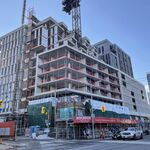Okay, I have had some time to go back and restudy the links I provided earlier. I was certain those links had the data, because I had read it before making the original posts, and I've read it months ago.
To get specifications on the Bombardier site you click the link for Light Rail or Tram, then you select the proper city, then you click "Technical Data" in the middle table.
This reveals car width for the Trams and Light Rail vehicles.
Here is an example of how to do this procedure, since it seems difficult for some people.
I chose Minneapolis, because its a North American example, and then I selected the tech specs for this example.
NOW, I will provide some examples.
Trams examples:
Geneva, Switzerland Tram; 2,300mm width, 42,000mm length
Krakow, Poland Tram; 2,400mm width, 26,000mm length
Light Rail examples:
Minneapolis Light Rail; vehicle width 2650mm, length per car 28,650mm
London-Croydon Light Rail; vehicle width 2,650mm, length per car 30,100mm
And you may select other options/cities as you desire.
Here are a few agreed on standards for the Bombardier Flexity Tram compared with the Bombardier Flexity Light Rail cars, both can rightfully be called "light rail" and I'm not disputing this. I've never said otherwise, and I think some of you have got a misunderstanding about what I'm trying to say and the information I've provided.
Flexity Trams:
*Generally are 300-400mm smaller in width. This is essentially 1+ foot smaller in width, and while it doesn't seem like a lot, for standing passengers its a noticable difference on a crowded train.
*Are not a modular design, generally speaking. They do not have connectors to allow two cars per train; however, they can come pre-assembled in several sectors/sections/dividers. Individually the trams can be longer than a light rail car (and many are) but they cannot be strung together and connected to another car. There are exceptions and customized versions, but generally speaking trams are just the one car with maybe two modules at most.
This is the Geneva Flexity Tram linked above. Notice the difference from the Flexity LRV: the tram has no connector in front to modularize it and put two train cars (even though this model is longer and has a few modules built-in). And its width is only 2,300mm which is a full foot less than the Minneapolis LRV.
Flexity Light Rail:
*Generally are 300-400mm bigger in width. They offer more standing room, and have higher capacity for standing passengers.
*Are modular in design. If one car (say it has two compartments) isn't enough, you can connect it to another car, they are "hot pluggable" and you can connect 4 cars if you wish, and disconnect them.
Flexity trams ARE NOT BUILT to be modular, they may come in two car trains, but they cannot be taken apart or plugged to another 2 car train. UNLESS TTC specifically requests a modification to be made (and yes, there are examples)
Here is an example of the light rail with the modular connection piece on front:
Those are the Flexity Light Rail vehicles in Minneapolis. They are hot pluggable, and you can double up the two-moduled cars and it can become 28,650x2=
57,300mm in length for rush hour traffic if they need to change it over. This can be done during off-peak hours at a train maintenance facility. And Light Rail Vehicles really don't have a "limit" it is more up to the station design. If a station can handle 4 large LRV's, then modular Light Rail Vehicles can do the job. Although using 4 large, modular Flexity LRV's like Minneapolis would need platforms capable of 28,650x4=
114,600mm. This is my single biggest concern with Eglinton LRT. I'd like all the platforms - above and below ground - to be able to accomodate at least 3 cars minimum like Minneapolis uses. This means the platforms NEED to be no less than 28,650x3=
85,950mm in length.
Trams may be 30,000+ mm in length, but most (unless a customized order is placed) are not modular in design, so a 40,000mm long tram can only be 40,000mm long unless its a modified, more expensive design. And I don't understand why the TC designers would want to waste a modified, custom design Light Rail vehicle that is a foot less in width.
ANOTHER difference, albeit slight, is that the Flexity Light Rail vehicles are rated for speeds up to 80-90kmph; Flexity Trams are generally rated no more than 70kmph. The reason why is because Light Rail technology requires the other aspects of construction to be higher grade and higher quality. This is extremely noticable in Portland (again, where I lived and experienced this difference for well over a year on a daily basis) where they have a modern
Tram/Streetcar working alongside
MAX Light Rail.
These are the differences we're talking about.
The argument I'm making is that I want to see Eglinton LRT use Flexity Light Rail vehicles that are modular in design, and have the extra foot of width for standing room over the 'tram' version of the Flexity that will be used for the TTC Streetcar replacement.
Obviously Light Rail, whether smaller trams or larger modular light rail vehicles, is not the same as the TTC subway. The TTC subway cars are a larger 3,134mm in width for considerably more standing room for passengers.
Source:
http://transit.toronto.on.ca/subway/5505.shtml
I hope this clears up any confusion in this discussion on train sizes, in particular with the Flexity series. Now that we know what kinds of trains they are using, its irrelevant to talk about the Boston T trams/light rail cars as they aren't anything like what we know TC will be using.
Better examples are to use Portland MAX, Minneapolis, etc.







